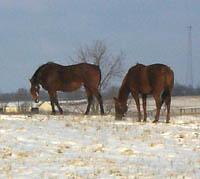2005 Was Good for State's Farmers; Next Year Could be Bright as Well
2005 Was Good for State's Farmers; Next Year Could be Bright as Well

Despite weather problems and other challenges, 2005 proved to be another good year for Kentucky farmers, and indications are 2006 could be a record for cash farm receipts barring any serious weather problems or world economic downturns.
Kentucky’s farm economy, once nearly a 50-50 split between crops and livestock, relies more on livestock today. The year 2005 saw a strong livestock sector, and economists don’t foresee a downturn in 2006, said Craig Infanger, a University of Kentucky College of Agriculture economist. Meanwhile, grain prices have been on a roller coaster in 2005.
UK economists estimate that Kentucky will have farm cash receipts of just more than $4 billion in 2005, just slightly below last year’s record level. Next year’s cash receipts could reach $4.14 billion.
Livestock cash receipts are up 6.3 percent in 2005, while grain receipts declined by 19 percent. Equine, poultry and cattle make up 89 percent of all livestock receipts. Equine receipts are expected to exceed $1 billion for the second time in history, making it the largest sector of the state’s farm economy at 23 percent. It is expected to reach about $1 billion again in 2006. Poultry follows close behind with receipts totaling $907 million, while beef cattle receipts likely will reach $652 million.
Also contributing to the economic good times in Kentucky is the strong agricultural export outlook, Infanger said.
“For the past two years, we’ve had record or near record exports up over $60 billion a year and the U.S. Department of Agriculture is predicting that those will continue into 2006,” he said. “Just keep in mind that about $1 billion of Kentucky ag products move into the export market every year, so we need a strong world economy and a strong export market to continue to earn the kind of cash receipts we are earning.”
UK agricultural economists Infanger, Will Snell, Lee Meyer, Steve Riggins and Tim Woods conducted their annual farm review and outlook last week at the Kentucky Farm Bureau convention in Louisville.
Infanger noted that cash receipts are increasing in western Kentucky while decreasing in eastern Kentucky. The shift is based on poultry production moving into the west while tobacco production has dropped in the east.
High cash receipts, federal farm program payments and tobacco buyout money are helping to ensure net farm income remains relatively strong despite increased costs for farm inputs. Net farm income in Kentucky is expected to be $1 billion this year, Infanger said. This year, government payments will be about 26 percent of net farm income.
“Good farm income coupled with a high level of USDA payments and high land values put Kentucky agriculture’s balance sheet in a very favorable context,” he said. “This is a strong agriculture sector right now. A growing world economy means we will continue to have the prospects of excellent exports and we need a strong export market. The USDA safety net and other programs are in place through 2007. One of the things we need to be thinking about is what’s going to happen with a new farm bill.”
While net income in 2006 looks to also remain strong, some areas of concern that may put a squeeze on it are increasing interest rates and higher input costs, he said.
Here are some additional highlights from the annual outlook conference.
• Tobacco cash receipts are estimated to drop below $300 million. This is down from more than $400 million from 2002-04, Snell said. However, farmers also received $240 million in their initial buyout payments in 2005. Grower lawsuit settlements and Phase II distribution payments accounted for another $200 million. An estimated $475 million was distributed when some farmers opted to take lump sum buyout payments, and approximately $200 million will be distributed in January when farmers not opting for the lump sum receive their second buyout payment.
In 2006, consolidation of growers will likely continue and it will likely take a 10-cent to 15-cent bump in burley tobacco contract prices to keep grower interest.
• U.S. corn growers produced their second 11 billion bushel crop. The huge crop will result in an increase in carryover stocks and keep price rallies in check. Soybean production was also high in 2005 and growers face a similar scenario of robust usage but building carryovers. Demand continues to increase for corn for use in ethanol, Riggins noted, and increased demand for soybeans is likely for use in biodiesel due to recent tax changes, the new energy bill and rising prices of energy.
• Kentucky fruit and vegetable production in 2005 likely will exceed $30 million. Woods noted that Kentucky’s horticulture marketing area still is in the development stage. Sales for the state’s fruits and vegetables come from farmers’ markets, roadside and farm markets, cooperatives, produce auctions and other niche marketing areas. Overall vegetable acreage could be down slightly in 2006, Woods said, but higher value market channels should keep sales steady.
Nursery crops are a $77 million industry in Kentucky. This industry, which includes nursery crops, landscape and greenhouses, has been increasing for the past 10 years as growers take advantage of the state’s climate and geographical location.
Writer: Laura Skillman 270-365-7541 ext. 278